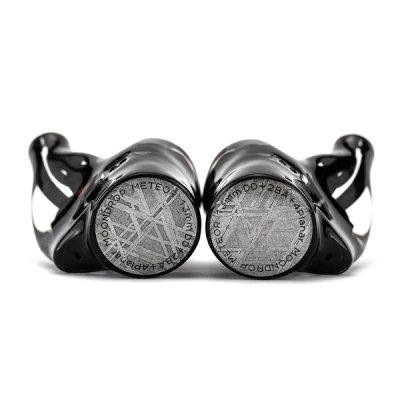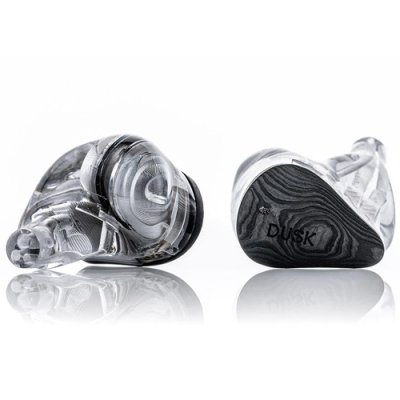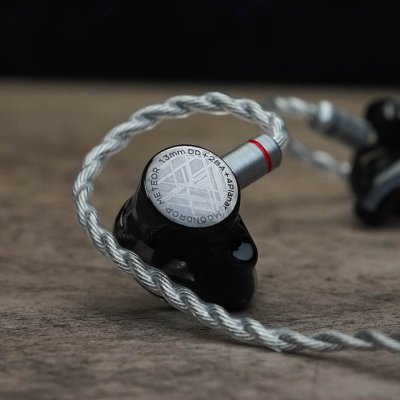Moondrop Meteor and Moondrop x Crinacle Dusk use 1DD+4BA+4PLA and 2DD+2BA+2PLA driver setups respectively. Moondrop Meteor costs $500 while Moondrop x Crinacle Dusk costs $400. Moondrop Meteor is $100 more expensive. Moondrop x Crinacle Dusk holds a clear 0.5-point edge in reviewer scores (7.3 vs 7.7). User ratings place Moondrop Meteor at 7.7 and Moondrop x Crinacle Dusk at 7.7. Moondrop Meteor has better mids with a 0.6-point edge, Moondrop Meteor has significantly better treble with a 1.3-point edge, Moondrop x Crinacle Dusk has significantly better dynamics with a 2-point edge and Moondrop Meteor has better soundstage with a 0.5-point edge.
Insights
| Metric | Moondrop Meteor | Moondrop x Crinacle Dusk |
|---|---|---|
| Bass | 7.3 | 7.3 |
| Mids | 8 | 7.4 |
| Treble | 9 | 7.8 |
| Details | 7.3 | 8 |
| Soundstage | 8 | 7.5 |
| Imaging | 7.3 | 7.5 |
| Dynamics | 5 | 7 |
| Tonality | 7.3 | 7.5 |
| Technicalities | 8.2 | 8 |
Moondrop Meteor Aggregated Review Score
Average Reviewer Scores
Average Reviewer Score:
7.3Generally Favorable
Moondrop x Crinacle Dusk Aggregated Review Score
Average Reviewer Scores
Average Reviewer Score:
7.7Strongly Favorable
Reviews Comparison
Moondrop Meteor reviewed by Jaytiss
Youtube Video Summary
Moondrop Meteor arrives as a hybrid with one dynamic, two BA mids, and four treble planars, now priced around $550. The shell is massive but well-contoured resin with a flat 2-pin connector; fit can be good after some tip rolling, though the nozzle runs large. The stock cable feels cheap for the price and the accessory pack is underwhelming—no DAC, a basic case—so the unboxing doesn’t add much value.
Tonally this is a treble-focused set that sounds clean, clear, and crisp, with pleasing air and microdetail. Bass is the weak link: quantity and slam are light, leaving dynamics and note weight on the lean side; lower mids could be richer. Graphs show typical Moondrop-leaning tuning that sits close to target but wants ~2–3 dB more bass. It measures stable with impedance, which, paired with precise imaging and tidy staging (good, not “huge”), makes it a plausible studio monitor-style choice.
Against peers, Variations brings more energy and is the safer pick; Moondrop’s own Concerto and even Caden-line sets feel fuller down low. Cheaper rivals like EPZ P50 and AFUL P7 offer more fun, while HiSenior Mega 5 EST and Softears Volume S present stronger overall value and bass presence. Verdict: a solid, airy detail-getter with attractive aesthetics, but not an upgrade to bass-richer favorites; recommended on the used market or with a discount, and an easy skip at full MSRP if seeking warmth and impact.
Jaytiss Youtube Channel
Buy Moondrop Meteor on Linsoul
Ad
Price: $439
Buy Moondrop Meteor on Linsoul
Moondrop x Crinacle Dusk reviewed by Jaytiss
Youtube Video Summary
Build impresses out of the box: a premium case, a handsome semi-transparent shell that’s a touch larger than AFUL’s Magic One, a smaller nozzle, and excellent comfort—easy A+. The included DSP cable feels great, while the analog cable comes off a bit cheap for the price. Packaging and accessories sit at an average level overall.
In analog form, this is a Jekyll-and-Hyde situation. Channel matching is spot-on, but the presentation reads flat/neutral to a fault—solid, yet not especially competitive, fitting more a $150–$170 tier for raw value. Versus the original Blessing 2 Dusk, the new Dusk extends better up top with more air, but from bass through upper mids (to ~8 kHz) the older set still vocals better and feels more engaging; upgrading for the analog tuning alone isn’t advised. Alternatives like the PULA PA02 or CKLVX 1DD+4BA hit a similar, clean-neutral aim, while Gizaudio Chopin shows a smarter 5–6 kHz dip, livelier mids, and punchier bass at roughly half the price. Among Crin collabs, it’s clearly more refined than the Dioko, but not a slam-dunk over his other budget-minded sets.
The story flips with the DSP. Engaged, the Dusk becomes an easy recommendation: noticeably more balanced, resolving, and simply fun, earning a “perfect score for value” within the DSP lane. Caveats: Android support is the sweet spot; iPhone compatibility can be finicky, pushing some users to desktop—where manual EQ already exists. Still, the app is simple, the extra tunings are useful, and plug-and-play convenience (no dongle DAC dance) is a win. Bottom line: as an analog IEM, only “good” and overpriced; as a DSP IEM, genuinely excellent—highly worth it if the use case fits.
Jaytiss Youtube Channel
Buy Moondrop x Crinacle Dusk on Aliexpress
Ad
Price: $399
Buy Moondrop x Crinacle Dusk on Aliexpress
Moondrop Meteor reviewed by Gizaudio Axel
Gizaudio Axel original ranking
Gizaudio Axel Youtube ChannelMoondrop x Crinacle Dusk reviewed by Gizaudio Axel
Gizaudio Axel original ranking
Gizaudio Axel Youtube ChannelMoondrop Meteor reviewed by Jays Audio
Youtube Video Summary
Moondrop’s new “flagship” Meteor lands with a decent first impression: a natural planar timbre that avoids the overly sizzly or peaky upper ranges found in rivals, and clean, forward vocals that shine on ballads at mid volume. The overall tuning sits neutral with a tilt toward female vocals, and technical performance is good—competitive but not class-leading at its bracket. Fit is on the thicker side with a quirky curve, so a demo is wise. The catch: the low end is tame to the point of feeling clinical, lacking slam, authority, and bass-guitar/drum texture in busier rock and metal. Treble is balanced with some extension, yet it lacks air and micro-nuance, making the presentation feel less special. Net result: more a side-grade to Dusk than an upgrade—and at $500+, that stings.
Energy genres expose more issues: the boosted 1–3 kHz pushes vocals shouty past ~60–65 dB and the set doesn’t scale well, especially with K-Pop/J-Pop and mainstream pop where even the Dusk can sound more engaging with better contrast and more low end. Value is the real problem: the EPZ P50 at roughly half the price brings more bass, more air, and similar accessories; competitors like IO Volare (4×EST), Oracle Mk1, or a sale-priced Variations offer smoother, airier treble, finer micro-detail, and better all-round balance. The Meteor’s use of micro-planars instead of ESTs, plus unchanged accessories (think Aria 2/Dusk level), makes the premium hard to justify. Overall, it edges sets like “Brain Dance/Damage” on timbre but gives up technicalities and versatility. Recommendation: skip—grab the P50, go IO Volare/Oracle/Variations, or EQ a Variations (fill the scoop, ease 1–2 kHz) for a result that outclasses Meteor. Bonus note: Moondrop’s new flagship Psyche also gets side-eyed—$2,000 without ESTs feels more cash-grab than value.
Jays Audio Youtube Channel
Moondrop x Crinacle Dusk reviewed by Jays Audio
Youtube Video Summary
Stock tuning lands in the safe-and-smooth lane: a gently warm balance with a slight treble emphasis, nothing egregious and nothing especially standout. It works well for J-pop/K-pop at mid volume thanks to tamed upper-mids that keep sibilance in check. The trade-off is softer, “vanilla” vocals that miss the last bit of extension, air, and micro-detail; turn it up for more presence and the treble gets spicy—not helped by unit variance that can throw a 16k peak. Cymbal detail is decent with minimal “planar timbre,” but it can get a touch sizzly.
Against the field, Dusk struggles to justify the premium. Truthear Nova plays the same all-rounder role for much less while feeling more open up top; want a bit more top-end than Nova, there’s the Chopin at ~$200. Hype 4 comes off as a more well-rounded Dusk—better low-end texture, a hint more vocal reach, and less sharpness—and Quintet delivers a similar idea for cheaper. Even with EQ in the mix, Blessing 3 can match or better the result (smoother treble, no channel imbalance). Net: the sound is good but not special, and the value calculus isn’t favorable.
The supposed differentiator—DSP—isn’t it. The app feels unstable (settings not applying, frequent crashes), Android-only for adjustments, and awkward with external DAC/amps where EQ may not pass through. There’s a minor noise floor between pauses. Of the presets, “Stock 3.5mm (Analog)” and Bass+ are the only keepers; “Stock USB” is warmer but needs more upper-mids, and the Diffuse Field Tilt lands awkwardly. Phone amps also bottleneck staging; better sources open it up—but then the DSP conflicts. Add in QC concerns, and the verdict is clear: a pleasant, inoffensive listen, yet overhyped and overpriced for what it delivers; a solid sub-$200 proposition, not at its current bracket.
Jays Audio Youtube Channel
Moondrop Meteor reviewed by Super* Review
Youtube Video Summary
The $500 Moondrop Meteor packs an oversized 13mm dynamic driver for bass, two balanced armatures for mids, and four micro planar drivers for treble. Objectively, its frequency response is fantastic—neutral with a tasteful sub-bass lift and exceptionally smooth, reserved treble that avoids harshness. Vocals sound natural and forward without edginess, and high-frequency percussion retains realistic timbre. Build quality impresses with a glossy, semi-transparent shell and a unique "meteorite" side panel, though the bulky design compromises fit stability versus sleeker Moondrop models. Accessories feel recycled from cheaper offerings, including a basic case and functional but kink-prone swappable-termination cable.
Subjectively, however, the Meteor feels unengaging. Its bass lacks punch and definition despite the large driver, coming across as soft and undynamic. Combined with the relaxed treble, this results in a lackluster sense of separation, layering, and imaging—music sounds cohesive but lacks incisiveness and visceral impact. While tonally balanced, the presentation is overly cautious, missing the excitement expected at this price. Even Moondrop’s own $360 Dusk outperforms it with tighter bass, sharper imaging, and greater overall engagement.
Comparisons highlight its shortcomings. The Dunu DK-31BD offers superior bass impact and more expressive treble at the same price, while the HiSenior Mega5EST delivers better definition and layering despite a warmer tilt. Ultimately, the Meteor’s excellent tuning can’t compensate for its dull technical performance. It’s a competent monitor but fails to justify its cost against rivals—or even Moondrop’s cheaper offerings.
Super* Review original ranking
Super* Review Youtube ChannelMoondrop x Crinacle Dusk reviewed by Super* Review
Youtube Video Summary
The new Moondrop x Crinacle Dusk borrows the Blessing 3’s ergonomics and accessory spread—spring tips, a lightweight 3.5 mm cable, and a braided USB DSP cable—while switching to a tribrid driver array: 2DD for bass, 2BA for mids, and 2 micro-planars for treble. The shell is medium-large yet secure and comfortable, with a narrower nozzle than earlier Blessings and a cleaner faceplate design. The DSP cable can sweeten tonality, but there are caveats: occasional artifacts, spotty DAP compatibility, and an Android-only app with EQ limits (no tweaks below ~60 Hz or above ~10 kHz).
On the analog cable, tonality lands neutral and mid-centric with a tasteful sub-bass lift and slightly eased presence region—still a touch clinical, but now with added body and engagement. The star is the bass quality: tight, punchy, and tactile without masking the mids. Imaging/separation are clearly above average, and treble has better extension and metallic timbre than older Moondrops. Swapping to the DSP cable warms the mids and adds a bit of mid-bass punch (less brightness, richer tone), trading a hint of separation for extra smoothness.
Comparisons: vs OG Dusk, the new set’s bass is less blammy but higher quality, and the treble timbre is more realistic; vs Blessing 3, this is fuller, deeper, and less thin; vs Hype 4, stage width and bass quantity favor the Hype, but the Dusk keeps vocals cleaner and more balanced. DSP experiments show Blessing 3 + DSP can get very close to the Dusk’s FR, and even the budget Moondrop May narrows the gap—yet the Dusk still wins on bass tightness, treble refinement, and overall technical polish. As an analog IEM around $360, this is the one to beat—an easy 5/5.
Super* Review original ranking
Super* Review Youtube ChannelMoondrop x Crinacle Dusk (more reviews)
Moondrop x Crinacle Dusk reviewed by Audionotions
Moondrop x Crinacle Dusk reviewed by Bad Guy Good Audio
Bad Guy Good Audio original ranking
Bad Guy Good Audio Youtube ChannelMoondrop x Crinacle Dusk reviewed by Kois Archive
Kois Archive Youtube Channel
Moondrop x Crinacle Dusk reviewed by Tim Tuned
Tim Tuned Youtube Channel
Moondrop x Crinacle Dusk reviewed by Shuwa-T
Moondrop x Crinacle Dusk reviewed by
 Fresh Reviews
Fresh Reviews
Youtube Video Summary
Moondrop x Crinacle Dusk earns raves for music: a clean, textured, fast low end with real sub-bass punch that avoids bloat, a natural, resolving midrange for male/female vocals and instruments, and crisp, well-controlled treble that delivers cymbal air without harshness. The overall presentation feels well-rounded and technical enough to spar with sets far above its price, evoking “revisit the whole library” vibes. Build and comfort impress too—lightweight shell, transparent chassis with a wood-like carbon faceplate, and an ergonomic fit. Tip-rolling matters: Spring Tips add a touch of openness and air, while SpinFit W1 tightens stage and teases out more bass on the “fish-mouth” nozzle.
Accessories are solid: a standard 3.5 mm cable plus a USB-C DSP cable that’s great for Android/iPad on-the-go listening, though PC gaming revealed instability in some titles (stutters/freezes in Apex Legends and Call of Duty). Day to day, the cable’s braid resists tangles, and the included case/tips round out a tidy package.
For competitive play, performance is mixed. Imaging is good and the bass gives an immersive punch, but the stage skews intimate and heavy effects can mask subtle cues. In Apex Legends, verticality and depth perception suffer—overhead action blends at forehead level, distant slides/grass shuffles fade, and chaotic fights cause layering to mush before quickly recovering. Call of Duty shows similar trade-offs with aerial and fine details under bombardment, while Valorant fares best thanks to tighter maps and fewer simultaneous effects (though horizontal peeks and micro-depth could still be sharper). The takeaway: S-tier for music in this bracket and a fun, cinematic gamer, but not the most surgical pick for top-ranked competitive play.
Fresh Reviews original ranking
Fresh Reviews Youtube ChannelMoondrop x Crinacle Dusk reviewed by Head-Fi.org
Moondrop Meteor Details
Driver Configuration: 1DD+4BA+4PLA
Tuning Type: Neutral, Bright
Brand: Moondrop Top Moondrop IEMs
Price (Msrp): $500
Support our free service! Buying through our affiliate links costs you nothing extra:
Moondrop x Crinacle Dusk Details
Driver Configuration: 2DD+2BA+2PLA
Tuning Type: n/a
Brand: Moondrop Top Moondrop IEMs
Price (Msrp): $400
Support our free service! Buying through our affiliate links costs you nothing extra:
Moondrop Meteor User Review Score
Average User Scores
Average User Score:
Based on 2 user reviews
7.7Strongly Favorable
Moondrop x Crinacle Dusk User Review Score
Average User Scores
Average User Score:
Based on 1 user reviews
7.7Strongly Favorable
Moondrop Meteor Gaming Score

Gaming Score & Grade
- The gaming score is prioritizing technical capabilities of the IEM (Separation, Layering, Soundstage) and good value.
Gaming Score
7.7Gaming Grade
AMoondrop x Crinacle Dusk Gaming Score

Gaming Score & Grade
- The gaming score is prioritizing technical capabilities of the IEM (Separation, Layering, Soundstage) and good value.
Gaming Score
7.6Gaming Grade
AMoondrop Meteor Scorings
Average Technical & Tuning Grades
Average Tunign Grade
A-- Expect an inviting tonal blend that adapts well to genres while staying largely composed. It strikes a nice blend of warmth and clarity.
Average Technical Grade
A+- Layering is confident and precise, backed by imaging that locks elements firmly in place. Micro-details peek through without sounding forced.
Moondrop x Crinacle Dusk Scorings
Average Technical & Tuning Grades
Average Tunign Grade
A- You get a polished tonal profile that stays natural from bass through treble. Subtle tuning choices keep things engaging.
Average Technical Grade
A+- You get an articulate, polished performance with immersive stage depth and great control. There's a sense of polish across the whole spectrum.
Moondrop Meteor User Reviews
Share your experience and build your personal ranking list.
You need to be signed in to write your own reviewNeutral, vocal focused. Not for bassheads.
Pros
vocals really sound lively and forward. Easy to get addicted to!Cons
chunky shellsA technically proficient tribrid offering refined, balanced sound with superb clarity and staging ideal for critical listening, though bass enthusiasts may find it reserved.
Pros
Exceptional treble detail without sibilance, natural midrange vocals, wide soundstage, premium build with unique meteorite faceplates, and excellent accessory package including modular cable.Cons
Bass lacks physical impact despite driver size, fit may challenge small ears due to large shells, and stock cable is stiff/tangle-prone.Buy Moondrop Meteor on Aliexpress
Ad
Price: $599
Buy Moondrop Meteor on Aliexpress
Moondrop x Crinacle Dusk User Reviews
Share your experience and build your personal ranking list.
You need to be signed in to write your own reviewMust use DSP default, much much better than analog
Pros
Very impressive across the board.Cons
Feels kinda "I don't want to hear them for a while" after long sessions. Not sure whyFind your next IEM:
IEM Finder Quiz
newIEM Comparison Tool
newVS






















